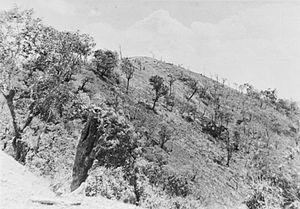
Back Операция „Уго“ Bulgarian অপারেশন ইউ-গো Bengali/Bangla Operació U-Go Catalan Operation U-gō German Operación U-Go Spanish عملیات یو-گو Persian Operaatio U-Go Finnish Opération U-Go French Operasi U-Go ID Operazione U-Go Italian
| U Go offensive | |||||||
|---|---|---|---|---|---|---|---|
| Part of the Burma Campaign in the South-East Asian theatre of World War II | |||||||
 The summit of Nippon Hill, east of Imphal, which was hotly contested during Operation U-Go | |||||||
| |||||||
| Belligerents | |||||||
| Commanders and leaders | |||||||
|
|
| ||||||
| Strength | |||||||
|
7 infantry divisions 1 tank brigade 2 infantry brigades |
5 infantry divisions 1 tank regiment 84,280 men (excluding INA) | ||||||
| Casualties and losses | |||||||
| 16,987–21,500[1][2] |
15th, 31st and 33rd Divisions: 12,443 killed 1,652 missing in action 8,407 dead from disease Misc. Army Troops: 8,000 dead from all causes Total: 30,502 dead, 23,003 hospitalized[3] | ||||||
The U Go offensive, or Operation C (Japanese: ウ号作戦, U Gō sakusen), was the Japanese offensive launched in March 1944 against forces of the British Empire in the northeast Indian regions of Manipur and the Naga Hills (then administered as part of Assam). Aimed at the Brahmaputra Valley, through the towns of Imphal and Kohima, the offensive along with the overlapping Ha Go offensive was one of the last Japanese offensives during the Second World War. The offensive culminated in the Battles of Imphal and Kohima, where the Japanese and their allies were first held and then pushed back.